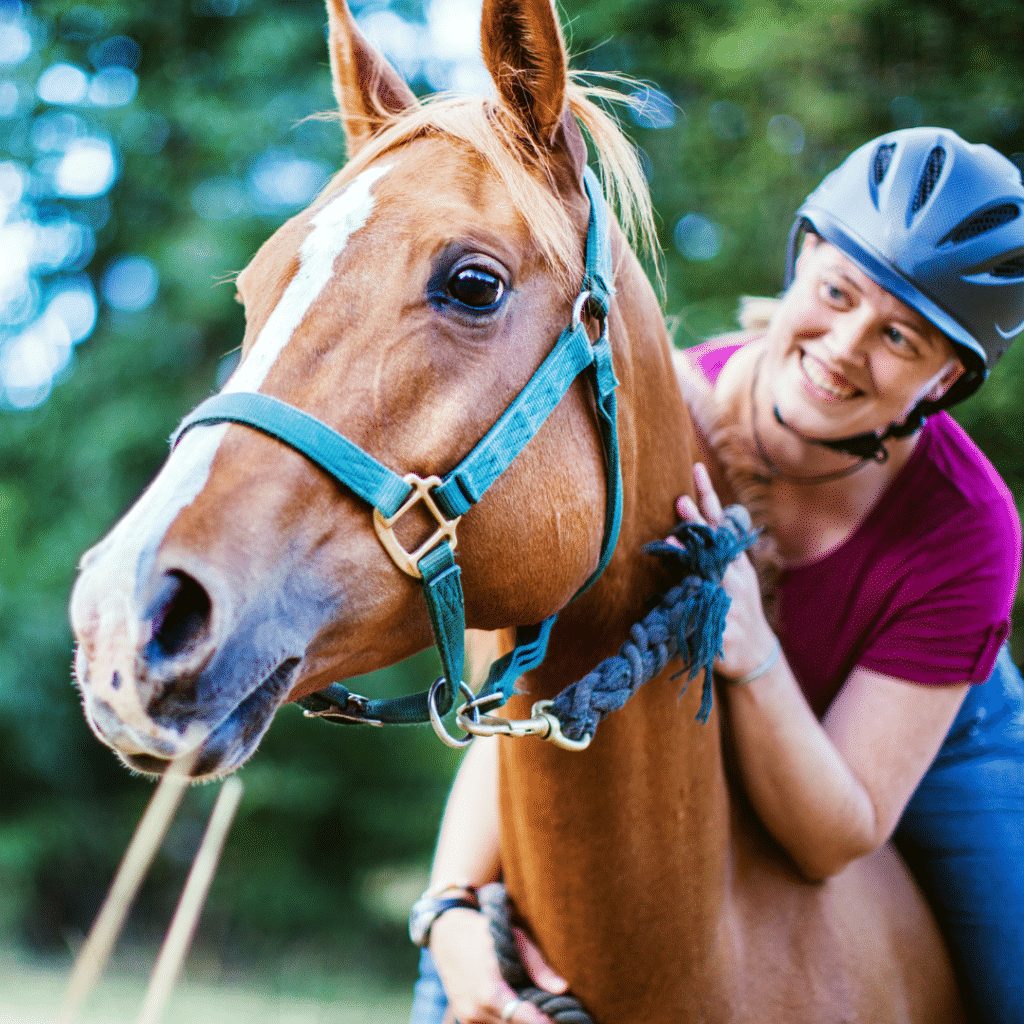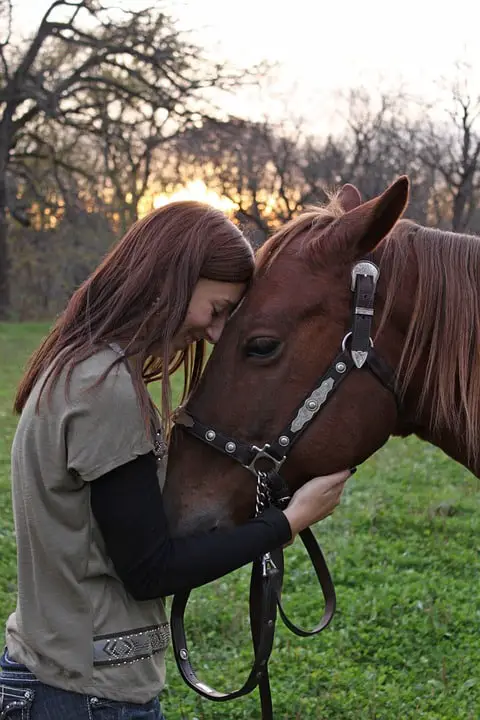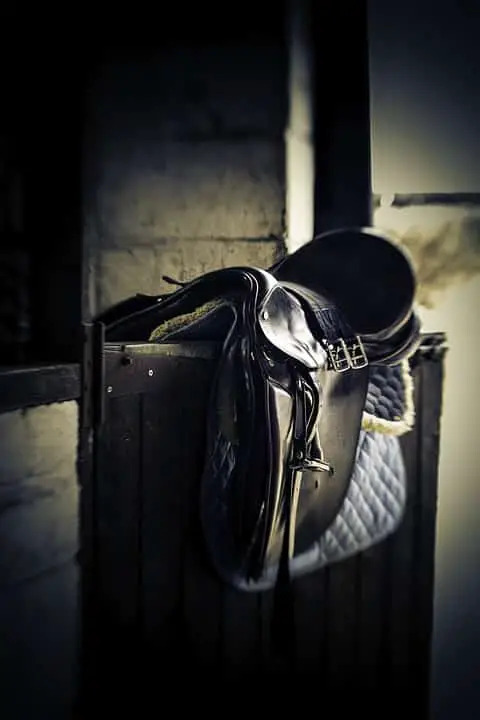In the movies, riders will jump on an unbridled horse and be able to ride flawlessly. Somehow the horse always knows the direction they’re supposed to go in, and the pace. But in the real world bridles are of great importance to give your horse directions and instructions. As you might expect, getting one that fits well can make a huge difference. So today I’m going to teach you how to measure for a bridle.
Okay, so are you a horse lover and want a new bridle for your horse? Are you confused about which size to pick and how to measure for a bridle? Well, let me guide you.
Bridles come in five standard sizes:
- Small pony
- Pony
- Cob
- Full size
- Oversize
I would always start with these standard sizes. Go to your local tack store and try a few standard sizes of bridles on your horse. If you find one that fits, your job is already done (except that you will need to pay for it, of course!).

The size of your horse does not always correlate to the size of their head
However, be prepared to discover that your horse may not have a standard size head. It may be smaller or larger, it could have a thicker throat latch, smaller nose or any other quality. It all depends on the type of your horse.
You may also want to buy your bridle online – and to do that, you’ll need to know how to measure your horse’s head!
Your horse will not be able to function properly with a tighter bridle or even a very loose bridle. You’ll always need a perfect size to ensure good performance from your horse.
Please keep in mind that wrong bridle measurements can put the rider and the horse’s health at risk. So it’s super important to make sure you’re measuring carefully, and following the guidelines below!
How to Measure for A Bridle
The only thing you’ll need to measure your horse’s head is a soft fabric measuring tape. If you don’t have one, you can use a long piece of string or ribbon, and then compare your measurements to a hard tape or ruler.
So let’s get measuring. You’ll need to measure these parts of your horse’s head:
- Crown piece and cheek piece.
- Brow band
- Noseband
- Throat latch
- Bit ring
Measuring the crown piece and cheek piece

The crown and cheek pieces starts from the corner of the horse’s mouth. They go over to the poll area and then back to the mouth. It’s like a U-shape.
To measure, start measuring from the mouth and go up to the first eye (this part is known as check piece, this gives the measurement of the cheek of a horse). Then cross behind horse’s head, reaching the second eye and running back to the mouth.
Most bridles have double cheek piece attached to crown piece, which runs across the cheeks to the bit ring.
Standard sizes of crown pieces and cheek pieces are listed below:
| Crown | Cheek | |
| Small Pony | 53 cm | 18 cm |
| Cob | 69 cm | 23 cm |
| Pony | 64 cm | 20 cm |
| Full size | 71 cm | 25 cm |
| Oversize | 76 cm | 28 cm |
Measuring the browband
This area covers the forehead of the horse. Start measuring from the base of one ear (start in the back corner), moving across the forehead to the second ear. Do not keep your tape too tight. If your browband is too tight it may pull the crown piece forward and disturb the bridle.
The browband is used to keep the bridle in a place and prevent it from sliding to the back side of ears when the rider puts pressure on it. It is also used to keep the throat latch fixed in place. It is recommended to keep it approximately one inch loose.
However, don’t make it too loose – you still want it to be comfortable for your horse.
Standard sizes of the browbands available on the market are:
| Small Pony | 36 cm |
| Pony | 37 cm |
| Cob | 40 cm |
| Full size | 43 cm |
| Oversize | 46 cm |
Measuring the noseband
Set your measuring tape about one inch below the end point of each of the cheekbones of your horse. Measure the circumference of this area. While you’re doing it, keep this area a bit loose. Otherwise it may apply too much pressure to your horse’s nose when reins are attached.

The noseband is directly attached to the crown piece. At the moment it’s trendy to use a wide noseband on your horse. However, some riders don’t put noseband on at all, to show off the beauty of their horse.
That said, it’s recommended for new riders to use noseband for better control over their horses. Let’s check out the list of standard sizes of the nosebands available on the market.
| Small Pony | 53 cm |
| Pony | 61 cm |
| Cob | 66 cm |
| Full size | 71 cm |
| Oversize | 76 cm |
Measuring the throat latch
The throat latch is used to prevent the bridle from slipping off over the head of horse when it rubs an object or when the rider pushes the bridle during riding. To measure this part, set the measuring tape on one ear of your horse.
Start measuring from the back side of the ear to downward below the throat latch and then up to the back edge of the other ear.
Proper measurement of the throat latch is very important. A tighter latch can hurt your horse while a very loose throat latch can slip over your horse’s head, which could cause you fall off.
So try to just keep it a bit loose. Approximately 2 inches (2 to 3 fingers) will be most comfortable for your horse. Look over the standard sizes of throat latch available in the market:
| Small Pony | 42 cm |
| Pony | 48 cm |
| Cob | 53 cm |
| Full size | 56 cm |
| Oversize | 58 cm |
Measuring the bit ring

The bit is a metal piece that rests on the sensitive part of the horse’s gums where there are no teeth. Bits are used to communicate with your horse while riding, to give commands and to control their movements. If you want to learn more about the different types of bits available, have a read of my guide to horse bits.
Measuring of the bit could easily seem like a tricky process. But it’s actually very easy!
Take a piece of ribbon and tie a knot on one side. Set the knotted side on the outside of the horse’s mouth, with the rest of the ribbon lying where the bit would be.
Fix it in your horse’s mouth, closing their mouth. Now gently pull the loose side of the ribbon, so that the knot comes in close to the corner of your horse’s mouth. Mark the other side that’s in your hand with a marker, as close as you can to the side of your horse’s mouth (but without getting pen in their mouth!). Then pull the ribbon out of the mouth of your horse. Now simply measure the length from the knot to your mark.
The length of the bit depends upon the size of the mouth of your horse. The standard size of a bit is 5 to 6 inches long.
Do I even need a bit?
Many riders now use a bit-less bridle. Bits are widely used to give instructions to the horse. But you can instruct the horse simply by using movements of your hands and legs, or by increasing or decreasing your grip on reins.
Bit can actually hurt your horse when used improperly. Only a very skilled rider can use a bit properly. Otherwise, you risk hurting your horse. I recommend not to use bit too frequently, even if you are a skilled rider.
Some tips on how to measure for a bridle
You don’t always need to take a measuring tape and run around your new horse to get the measures of their head. Instead, you can simply ask their last owner to give you their size or old bridle. That way you could easily measure the bridle, note the values and get a new one.

If this is a horse you’ve owned for a while, simply measure their old bridle or bring it shopping with you and get the same size.
Or you can borrow a bridle, try it on your horse and estimate their size.
If your horse is between sizes, generally I would go for the one it’s closer to. For example, if your horse’s size is between cob and full size and more close to the cob, purchase the cob. Keep in mind that the leather stretches over time, so you want to avoid something that is too loose. If you are buying the horse tack for the first time, I have lots of other helpful tips you can check out!
Need more help? Here is a quick video on how to bridle a horse:
Feel free to comment if you have any questions 🙂
Happy riding!

